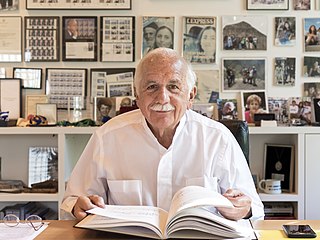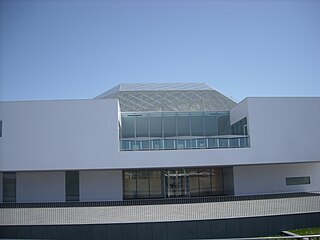Related Research Articles

Moshe Safdie is an architect, urban planner, educator, theorist, and author, with American, Canadian, and Israeli citizenship. He is known for incorporating principles of socially responsible design in his 50-year career. His projects include cultural, educational, and civic institutions; neighborhoods and public parks; housing; mixed-use urban centers; airports; and master plans for existing communities and entirely new cities in North and South America, the Middle East, and Asia. He is most identified with designing Marina Bay Sands and Jewel Changi Airport, as well as his debut project, Habitat 67, originally conceived as his thesis at McGill University.

Douglas Joseph Cardinal is a Canadian architect based in Ottawa, Ontario. His flowing architecture marked with smooth curvilinear forms is influenced by his Indigenous heritage as well as European Expressionist architecture. His passion for unconventional forms and appreciation of nature and landscape were present in his life from a very young age, and consequently developed into the unique architectural style he has employed throughout his career. Cardinal is perhaps best known for his designs of the Canadian Museum of History in Gatineau, Quebec (1989) and the National Museum of the American Indian in Washington, D.C. (1998). He is considered one of Canada's most influential contemporary Indigenous architects.
Bruce Bunji Kuwabara, is a Canadian architect and a founding partner of the firm KPMB Architects. He is an invested Officer of the Order of Canada and recipient of the RAIC Gold Medal. He is Board Chair of the Canadian Centre for Architecture in Montreal.

Roderick George Robbie was a British-born Canadian architect and planner. He was known for his design of the Canadian Pavilion at Expo 67 and Toronto's Rogers Centre (SkyDome).

The Delegation of the Ismaili Imamat in Ottawa, Ontario, Canada is representational office of the Ismaili Imamat in Canada and includes the headquarters of the Aga Khan Foundation Canada. It is located between the Embassy of Saudi Arabia and the Lester B. Pearson Building on Sussex Drive. It was opened in 2008.
WZMH Architects is an architectural firm established in 1961 and based in Toronto, Ontario, Canada. Originally known as Webb Zerafa Menkès Housden the company's name was changed to WZMH Architects in 2002.
Siamak Hariri, OAA, AAA, AIBC, FRAIC, RCA, Intl. Assoc. AIA is a Canadian architect and a founding partner of Hariri Pontarini Architects, a full-service architectural and interior design practice based in Toronto, Canada.
Zeidler Architecture is an international architecture, interior design, urban design, and master planning firm with four Canadian offices located in Toronto, Calgary, Vancouver, and Victoria. In addition, the firm has locations in Beijing (China); and Berlin (Germany).
George Edward Bemi was a Canadian architect who practiced in Ottawa, Ontario, from 1955 to 2005. During his prolific career, he contributed over 300 buildings to the National Capital area, including significant projects such as St. Basil's Church, the Main Branch of the Ottawa Public Library, the downtown YM-YWCA, and the Ottawa Police Headquarters. His buildings are primarily designed in a Modernist or Brutalist style of architecture, characterized by massive concrete forms, asymmetrical volumes, curtain wall, honest materiality, and a play between solids and voids.
Hariri Pontarini Architects is a Toronto-based architectural practice founded by Siamak Hariri and David Pontarini.
KPMB is a Canadian architecture firm founded by Bruce Kuwabara, Thomas Payne, Marianne McKenna, and Shirley Blumberg, in 1987. It is headquartered in Toronto, where the majority of their work is found. Aside from designing buildings, the firm also works in interior design. KPMB Architects was officially renamed from Kuwabara Payne McKenna Blumberg Architects to KPMB Architects on February 12, 2013.
Helga Plumb is a Canadian architect known for her post modern and environmentally friendly design. She was born in Bruck/Mur, Austria in 1939. Plumb left Austria at the age of 20, and emigrated to Canada, where she settled in Toronto in 1959.
Arcop was an architectural firm based in Montreal, renowned for designing many major projects in Canada including Place Bonaventure, Place Ville-Marie and Maison Alcan. The firm was originally formed as a partnership under the name Affleck, Desbarats, Lebensold, Michaud & Sise between Ray Affleck, Guy Desbarats, Jean Michaud, Fred Lebensold and Hazen Sise, all graduates and/or professors at the McGill School of Architecture. In 1959, after the departure of Michaud and the addition of Dimitri Dimakopoulos, another McGill Architecture graduate, the firm was renamed Affleck, Desbarats, Dimakopoulos, Lebensold, Sise which it maintained for a decade afterward. The company did not adopt the name Arcop, which stands for "Architects in Co-Partnership", until 1970.
Marianne McKenna, OC, FRAIC, OAA, OAQ, AIA, RIBA is a Canadian architect and a founding partner of KPMB Architects, a Toronto-based practice established in 1987. She is an invested Officer of The Order of Canada "for her contributions as an architect, designing structures that enrich the public realm". Her projects include the renovation and expansion of The Royal Conservatory TELUS Centre for Performance and Learning and Koerner Hall. McKenna and KPMB were selected by The Brearley School, an independent all-girls school located in New York City, to lead the renovation of its building located on the Upper East Side. Her current projects also include for Banff Centre for Arts and Creativity in Banff, Alberta and an expansion and renovation of historic Massey Hall in Toronto In 2010 she was named one of Canada’s Top 100 Most Powerful Women and in 2014 she was named one of Toronto’s top 50 Powerful People by MacLean’s Magazine.
Blanche Lemco van Ginkel was a British-born Canadian architect, city planner, and educator who worked mostly in Montreal and Toronto. She is known for her Modernist designs, as well as for planning Expo 67 and spearheading the preservation of Old Montreal. Lemco van Ginkel was the first woman to head a faculty of architecture in Canada and be elected a member of the Royal Canadian Academy of Arts. She was also the first woman to be awarded a fellowship by the Royal Architectural Institute of Canada and in 2020, was awarded their highest honour, the RAIC Gold Medal.
Brigitte Shim, FRAIC, OC, RCA, Hon. FAIA, OAA is a Canadian architect known for her small house designs in Canada and other works in architecture of different scales. Shim is a founding partner of Shim-Sutcliffe Architects, along with her husband, Howard Sutcliffe. Before the establishment of Shim-Sutcliffe Architects in 1994, she was a practicing architect who also taught at the University of Toronto's John H. Daniels Faculty of Architecture, Landscape and Design. She continues to guide young designers as a tenured professor at University of Toronto and as a visiting professor to many other institutions until today. Her works span different scales in architecture, ranging from chairs to public facilities. Her work often shows an interest in the relationship between architecture and nature. Her work has garnered awards such as over a dozen Governor General’s Medals for architecture. Shim is an invested officer of The Order of Canada for her significant contributions to the country.
Shirley Blumberg is a Canadian architect. She is a founding partner of KPMB Architects in Toronto, a Canadian practice. In 2013, Blumberg was invested as a Member of the Order of Canada "for her contributions to architecture and for her commitment to creating spaces that foster a sense of community." Notable projects include the Centre for International Governance Innovation (CIGI) Campus, 2011 which is the recipient of the Royal Institute of British Architects International Award (2012), the Architectural Record “Good Design is Good Business Award” (2013) and the Governor General's Medal for Excellence (2014).
Eva Hollo Vecsei is a Hungarian-Canadian architect. She began her career in Budapest and emigrated to Montreal in 1957, where she established Vecsei Architects with her husband in 1984.
Claude Provencher OAQ, OAA, AAPPQ, ARAC (RCA), FRIAC was a Canadian architect. In 1983, together with Michel Roy he founded the architecture firm Provencher_Roy in Montréal. He is considered one of the pioneers of modern urban architecture.
Heather Dubbeldam, OAA, FRAIC, LEED AP, WELL AP is a Canadian architect based in Toronto. She received the 2016 Prix de Rome in Architecture for her research on sustainable housing. In 2003, Dubbeldam founded Dubbeldam Architecture + Design a midsized multidisciplinary firm. Prior to starting her own firm, she worked for Kuwabara Payne McKenna Blumberg (KPMB), where she gained her architectural license. Beyond architectural practice, Dubbeldam contributes to the architectural community as a volunteer on various boards. These boards include: Building Equality in Architecture Toronto, Twenty + Change, and the Design Industry Advisory Committee. Her volunteering also includes affiliations with multiple architectural schools as a critic and advisory council member.
References
- ↑ Perks, Christina (Feb 9, 1993). "More success stories". The Globe and Mail.
- 1 2 3 4 5 6 "Canadian Women Artists History Initiative : Artist Database : Artists : PERKS, Christina Poznanska Outerbridge". cwahi.concordia.ca. Retrieved 2020-03-26.
- 1 2 Perks, Christina (2011). "My Summer Employment in an Architectural Office" (PDF). OAA Perspectives. 19– via Ontario Association of Architects.
- ↑ Adams, Annmarie (2000). Designing Women: Gender and the Architectural Profession. University of Toronto Press. p. 84.
- ↑ "WOMEN IN ARCHITECTURE". www.arvha.org. Retrieved 2020-03-26.
- ↑ RAIC Book of Fellows 2018. Royal Architecture Institute of Canada. 2018.